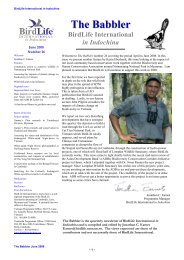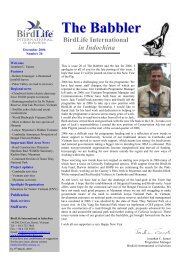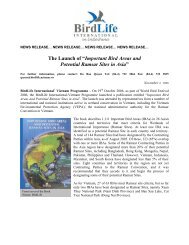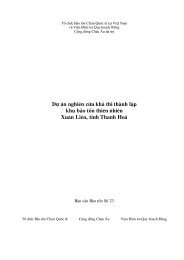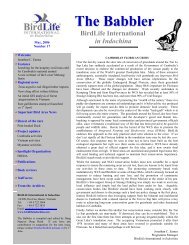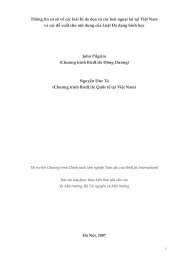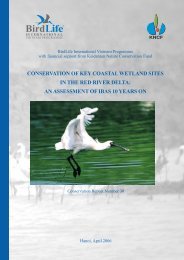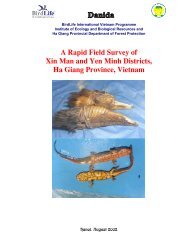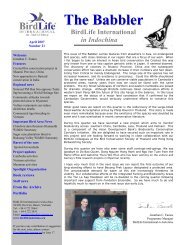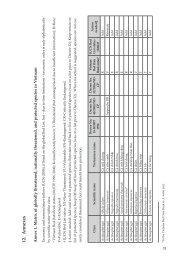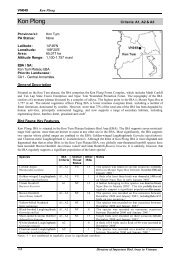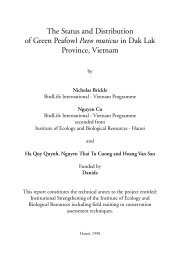A Feasibility Study for the Establishment of Xuan Lien Nature ...
A Feasibility Study for the Establishment of Xuan Lien Nature ...
A Feasibility Study for the Establishment of Xuan Lien Nature ...
You also want an ePaper? Increase the reach of your titles
YUMPU automatically turns print PDFs into web optimized ePapers that Google loves.
Section 2 - Site Features<br />
be as low as 1,060 mm in some years. The foothills have between 120 and 130 rainy days per year, while<br />
<strong>the</strong> mountains have 149 or 150. Evaporation is higher in <strong>the</strong> foothills (900 to 1,000 mm/year) than in <strong>the</strong><br />
mountains (700 to 800 mm/year).<br />
6<br />
2.5 Hydrology<br />
There are three main river systems in <strong>the</strong> nature reserve:<br />
(a) Chu River Basin. The Chu River is <strong>the</strong> second largest river in Thanh Hoa province. The<br />
Chu River originates in Laos and flows through Nghe An province be<strong>for</strong>e passing through<br />
<strong>the</strong> proposed nature reserve. The Chu River is important <strong>for</strong> <strong>the</strong> transportation <strong>of</strong> goods<br />
and produce, water resources, hydro-electricity, irrigation, and drainage. The area <strong>of</strong> <strong>the</strong><br />
Chu River watershed is 81,594 ha, excluding a section in Laos. The river bed is narrow,<br />
running through areas <strong>of</strong> high, sloping topography and has rapid currents. Table 2<br />
summarises <strong>the</strong> hydrological features <strong>of</strong> <strong>the</strong> Chu River, measured at Bai Thuong Dam.<br />
Table 2: Hydrological Features <strong>of</strong> <strong>the</strong> Chu River at Bai Thuong Dam<br />
Hydrological Feature Measurement<br />
Average annual flow volume (m 3 /yr) 4.57 x 10 9<br />
Average flow rate (m 3 /s) 145<br />
Dry season flow rate (m 3 /s) 23<br />
Rainy season flow rate (m 3 /s) 6,700<br />
Maximum (rainy season) water level (m) 21.41<br />
Minimum (dry season) water level (m) 15.80<br />
(b) Cao River Basin. The Cao River (also known as <strong>the</strong> Khao River) is <strong>the</strong> largest tributary <strong>of</strong><br />
<strong>the</strong> Chu River and has a catchment <strong>of</strong> 30,587 ha. The river originates in <strong>the</strong> mountains in<br />
Bat Mot commune, runs through Yen Nhan and <strong>Xuan</strong> Khao communes and meets <strong>the</strong><br />
Chu River at Lang Thon village. The upstream reaches <strong>of</strong> <strong>the</strong> Cao River are very narrow<br />
and steep, with many waterfalls; Tieu waterfall in Bat Mot commune, <strong>for</strong> example, is more<br />
than 60 m high.<br />
(c) Kue River Basin. The Kue River (also known as <strong>the</strong> Nam Bung) is also a large tributary <strong>of</strong><br />
<strong>the</strong> Chu River. It drains <strong>the</strong> sou<strong>the</strong>rn section <strong>of</strong> <strong>the</strong> study area. The river originates on <strong>the</strong><br />
south-facing slopes <strong>of</strong> Ban Mua and Bu Hon Han mountains and flows through Bat Mot,<br />
and <strong>Xuan</strong> <strong>Lien</strong> communes be<strong>for</strong>e meeting <strong>the</strong> Chu River at <strong>the</strong> border between Thanh<br />
Hoa and Nghe An provinces.<br />
In addition to <strong>the</strong> Cao and Kue Rivers, numerous smaller tributaries <strong>of</strong> <strong>the</strong> Chu River originate in <strong>the</strong><br />
study area. These include <strong>the</strong> Hon Yen stream originating on <strong>the</strong> north-east-facing slopes <strong>of</strong> <strong>the</strong> Bu<br />
Cho and Ta Leo mountains in <strong>the</strong> east <strong>of</strong> <strong>the</strong> study area. In general, water courses in <strong>the</strong> study area are<br />
permanent and fringed by intact <strong>for</strong>est cover.<br />
Surveys were undertaken at several sites to assess <strong>the</strong> hydrogeology <strong>of</strong> <strong>the</strong> region. Water was found at 1<br />
to 2 m below <strong>the</strong> surface at most sites located in valleys. The lowest water-table was found to be 7 to 8<br />
m below <strong>the</strong> surface. These results indicate that groundwater is abundant in <strong>the</strong> area. However, this is<br />
only a preliminary assessment <strong>of</strong> underground water resources due to <strong>the</strong> dearth <strong>of</strong> data on <strong>the</strong><br />
groundwater characteristics <strong>of</strong> <strong>the</strong> region




